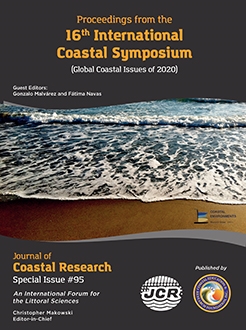Ndour, A.; Ba, K.; Almar, A.; Almeida, P.; Sall, M.; Diedhiou; P.M., Floc'h, F.; Daly, C.; Grandjean, P.; Boivin, J-P; Castelle, B.; Marieu, V.; Biausque, M.; Detandt, G.; Tomety Folly, S.; Bonou, F.; Capet, X.; Garlan, T., Marchesiello, P.; Benshila, R.; Diaz, H.; Bergsma, E.; Sadio, M.; Sakho, I., and Sy, B.A., 2020. On the natural and anthropogenic drivers of the Senegalese (West Africa) low coast evolution: Saint Louis Beach 2016 COASTVAR experiment and 3D modeling of short term coastal protection measures. In: Malvárez, G. and Navas, F. (eds.), Global Coastal Issues of 2020. Journal of Coastal Research, Special Issue No. 95, pp. 583-587. Coconut Creek (Florida), ISSN 0749-0208.
West Africa's low and densely populated coasts crystallize most of the environmental and societal problems and resulting vulnerability. It is becoming urgent to document this coast and the natural and anthropogenic forces to understand its evolution. Saint Louis is a historic (World Heritage) city located on the Langue de Barbarie, a 10 km sandspit at the mouth of the Senegal River. Because of its location, it is vulnerable (erosion, flooding) to river and ocean variability. This intermediate barred microtidal beach is located in a storm-free intertropical environment, but is exposed to distant oblique energetic waves from high latitudes, causing one of the highest coastal drifts in the world (∼800,000 m3/year). As part of the COASTVAR project, an intensive international field experiment was conducted in Saint Louis from 4 to 13 December 2016 to quantify the natural protective role played by the sandbar, coastal currents and transient exchanges with the inner shelf. Many instruments have been deployed to measure waves, currents, bathymetry and topography. This article provides an overview on the objectives of the experiment, the deployment and the first results of the modeling of coastal protection strategy.





